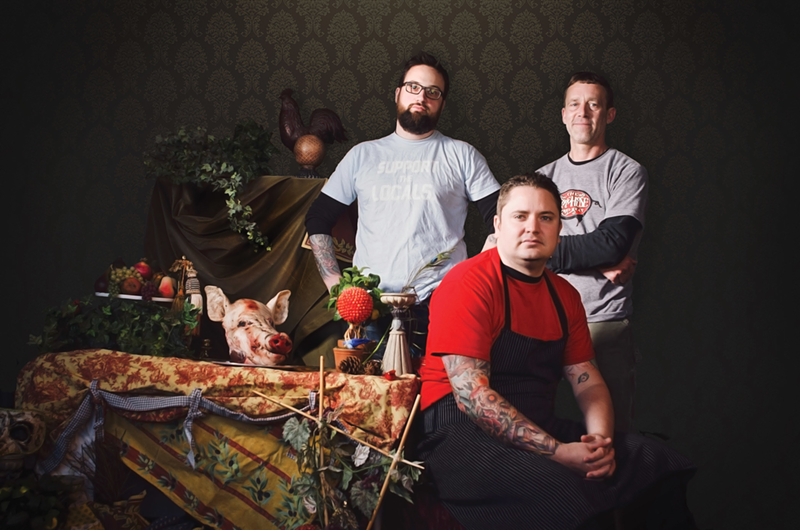click to enlarge 
L to R: Chef Mike Florea, Chef Kyle Johnson, Justin Dean
If there were a time machine that could magically transport us back to the Cincinnati of the 1820s, downtown’s Central Parkway would look exceedingly different than it does today. In fact, it wasn’t a parkway at all but the Miami and Erie Canal, which connected Lake Erie to the Ohio River, allowing farmers from Northern Ohio to bring their hogs down to Cincinnati and ship them all over via the river. It was this ability to transport such large amounts of pork that allowed Cincinnati to become a huge pork-packing city and earn the lasting nickname “Porkopolis.” To Cincinnati’s vast German population, the canal became known as the “Rhine,” a reference to Germany’s Rhine river, thereby giving the neighborhood where they resided the name “Over-the-Rhine.” Pork played a large part of the German diet. It was delicious, plentiful and, most importantly, inexpensive. And, in the traditional way, every part of the animal was utilized in cooking so as not to be wasteful.
As times, palates and belt sizes changed, pork played a less important role in the American diet. Beef became “What’s for Dinner,” chicken was for those looking to shed a few pounds and pork fell by the wayside as far too fattening. In 1987, in an effort to combat this, U.S. farmers were encouraged to breed less fatty hybrid pigs, and the National Pork Board introduced the “Pork. The Other White Meat” advertising campaign. The result was bland, dry, tasteless meat. For the most part, chefs became disinterested in serving pork.
Enter British chef Fergus Henderson. Henderson’s 1999 book Nose to Tail Eating: A Kind of British Cooking celebrates the use of every part of the animal because, as he sees it, to do otherwise would be wasteful and impolite to the animal after you’ve “knocked its head off.” Most of the dishes in the book were developed using recipes from out-of-print cookbooks from the 1950s, and Henderson’s philosophy quickly gained steam among chefs and diners alike.
Cincinnati chefs are embracing this whole hog philosophy as well. They’re working closely with farmers who are producing tastier heritage breed hogs and creating dishes that utilize less traditional cuts of meat — those outside of what consumers are used to seeing wrapped in plastic in a grocery store case. The resulting dishes might push people’s palates a bit, but for the most part diners are open to trying new things.
Chef Mike Florea of Maribelle’s eat + drink definitely embraces Cincinnati’s Porkopolis heritage when planning his dishes.
“Between the pig and Cincinnati’s German background it is always in the back of my mind,” he says. “I like to create food that the old school is able to appreciate while also introducing things like goetta to the youngsters.”
According to Florea, one of the city’s more famous meat dishes, goetta, was created when pig farms by the river flooded and they had to stretch the amount of available pork to feed more people. “That’s where oats came in,” he says, “creating a ‘poor man’s terrine’ with ground pork and oats. We proudly serve homage to the city by making our own goetta.”
For chef Jose Salazar of the soon-to-be-opened Salazar restaurant in OTR, the increase in whole-animal consumption comes down to economics and chef preference.
“I’d say that the recession brought on the use of less expensive cuts of meat in general, including pork,” he says. “The bellies, shanks and shoulders started popping-up on menus and became almost as common as the chops, hams and tenderloins.”
“Secondly, I think that we Americans are raising heritage breed animals more and more, so chefs are more inclined to want to use them,” he continues.
Chef Ryan Santos of Please agrees. He works with local farmers and finds the difference in flavor depending on the breed and type of feed fascinating.
“I think there are a lot of local producers doing all kinds of different heritage-type pigs and they all end up on menus around town,” he says. “It’s interesting as a chef to work with them all and find what makes each one unique, whether its flavor or amount of fat. The same cut of pork from different producers around town can be completely different in so many ways. From Bill Dean’s Red Wattle pigs to the acorn-fed Woodlands Pork pigs to Tricia Houston’s spent-grain fed pigs at Napoleon Ridge Farm.”
Since 2009, downtown restaurant Local 127 has featured a dish called “Porkopolis” on its menu. Chef Kyle Johnson describes it as a dish that, “frequently changes, utilizing cuts from the whole hog, from pluma (the cut that is joined to the loin at the bottom end) to presa (the muscle between the top of the shoulder and the beginning of the loin), to tenderloin, braised belly and sausage over braised greens and beans. The possibilities are endless with this dish.”
And Johnson finds that Cincinnati diners are absolutely open to nose-to-tail eating.
“Most diners I see here … are excited about it,” he says. “They are fascinated with utilization for the whole hog.”


